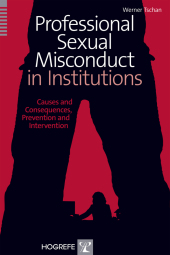 Neuerscheinungen 2014Stand: 2020-02-01 |
Schnellsuche
ISBN/Stichwort/Autor
|
Herderstraße 10
10625 Berlin
Tel.: 030 315 714 16
Fax 030 315 714 14
info@buchspektrum.de |

Werner Tschan
Professional Sexual Misconduct in Institutions
Causes and Consequences, Prevention and Intervention
1. Aufl. 2014. XVI, 216 S. 22.8 cm
Verlag/Jahr: HOGREFE PUBLISHING 2014
ISBN: 0-88937-444-9 (0889374449)
Neue ISBN: 978-0-88937-444-7 (9780889374447)
Preis und Lieferzeit: Bitte klicken
Essential reading about a notoriously difficult problem: how abusive professionals
manipulate their clients and what we as organizations and individuals can do
about it.
Professional sexual misconduct (PSM) is a problem that is notoriously difficult to address
and that can be a minefield for all concerned - for victims, for the institutions
where it takes place -, and also because outstanding and supposedly responsible
members of society may be accused of abuse.
Here, Werner Tschan, one of the world´s leading experts in dealing with PSM, outlines
an up-to-date approach to PSM and professional disruptive behaviors. He
describes practical ways to prevent PSM, as well as effective treatments for victims
and to rehabilitate offenders on those accused. Using examples from real-life cases
from around the world, he also discusses how PSM is a societal problem and what
we can do to stop it. Recent headline cases involving a variety of organizations -
medical, media, church, schools, sport, industry - show that institutions can be
ideal environments for PSM, and so great emphasis is placed in this volume on
preventive measures that we can and must take at an institutional level.
With clear, jargon-free writing this book is essential reading for all professionals
interested in preventing and dealing with PSM, as well as of interest to victims
and their families.
Foreword
Dedication
Preface
Survivor´s Voice: A True Story of an Elderly Man
Reaching Out for Help
1 Introduction
1.1. Historical Background; 1.2 Children´s Lies - The Backlash
After 1900; 1.3 The End of "Hystories"; 1.4 Developments
in Europe; 1.5 New Penal Codes; 1.6 Public Awareness;
1.7 Awareness Psychology
2 How to Understand Survivors´ Reactions
2.1 Attachment Theory; 2.2 Trauma and Its Consequences;
2.3 Delayed Onset of Symptoms; 2.4 Overcoming
Trauma; 2.5 Society´s Answer to Trauma
3 What Is PSM and How Does it Happen
3.1 What Is PSM?; 3.2 What Is the Magnitude of PSM?; 3.3
The spectrum of offense; 3.4 Who Becomes a Victim of
PSM?; 3.5 What Are the Consequences of PSM?; 3.6 How
Can PSM Be Discovered?; 3.7 False Accusations of PSM;
3.8 What Helps Victims of PSM?; 3.9 Liability Questions;
3.10 Who Becomes an Offender Professional?; 3.11 Sexuality
and PSM; 3.12 Punishment or Treatment?
4 PSM in Various Disciplines
4.1 Health Care Professionals; 4.2 Psychotherapy and
Counseling; 4.3 Social Work; 4.4 Care Homes; 4.5 Religion;
4.6 Education; 4.7 Sports and Leisure Time Activities; 4.8
Justice System; 4.9 Military
5 The Overlap with Workplace Violence
5.1 The Culture of Organizations as a Management Task;
5.2 Sexual Harassment; 5.3 Bullying; 5.4 Stalking; 5.5
Physical Violence; 5.6 The Decision-Making Process; 5.7
Problem-Solving Attempts; 5.8 Prevention of Workplace
Violence
6 The Impact of PSM on Survivors, Institutions, and
Professionals
6.1 From Victim to Survivor; 6.2 Consequences for
Offender Professionals; 6.3 Consequences for the Institution;
6.4 Consequences for Society
7 Treatment of Survivors
7.1 Realizing; 7.2 Finding Help; 7.3 Processing; 7.4 Integration;
7.5 Overcoming; 7.6 Healing; 7.7 From Victim to
Offender
8 Why Do Professionals Commit Sexual Offenses?
8.1 The First Meeting; 8.2 Treatment Procedure; 8.3 The
Path to PSM; 8.4 Offender Strategies; 8.5 Homework During
the Treatment Program; 8.6 Evaluation and Termination
of Program; 8.7 Prognosis
9 Prevention of PSM in Institutions
9.1 Effective Complaint Mechanisms; 9.2 False Accusations;
9.3 The Decision-Making Process; 9.4 An Integrated
Approach
10 Boundary Training
10.1 A New Paradigm: Rehabilitation After PSM; 10.2 The
24 Modules; 10.3 Who Should Undergo Boundary Training?;
10.4 Boundary Training in Professional Formation
and Further Development; 10.5 We Don´t Need to Re-
Invent the Wheel
11 Assessment and Rehabilitation of Affected Professionals
11.1 Assessment; 11.2 Rehabilitation Program; 11.3 Critical
Questions; 11.4 Case Consultation and Supervision;
11.5 Economic Consequences; 11.6 Risk Management
12 Prevention Overview
12.1 Victim Counseling Services and Other Requirements;
12.2 Curricular Integration; 12.3 Paradigm Shift in Justice;
12.4 The Three Pillar Model for Effective Prevention


